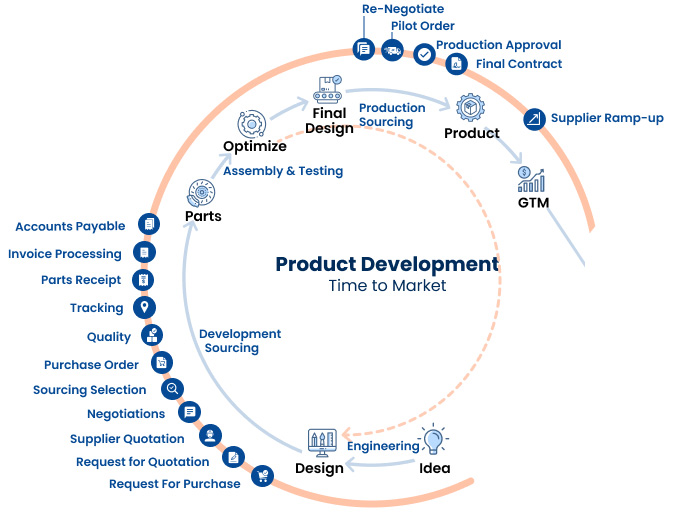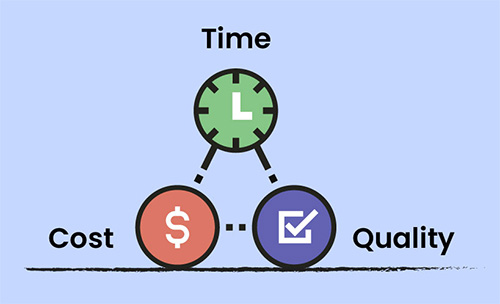How an Effective Source-to-Pay Solution for Direct Materials helps in Product Success
Business | March 29, 2023 | By
In Product Manufacturing companies, the role Sourcing & Procurement teams play is critical in the success of a product. However, most companies do not fully understand the impact of these roles. And because of this, the siloed approach, distrust between functions and a lack of consensus for collective improvement continues. On the other hand, when there is a strong synergy between the procurement and product development functions, the agility and success of the product development process and the control of their Time-to-Market is quite exciting to watch.
A general overview of the product development process is shown in the illustration below. This does not cover the details of the engineering tests or a manufacturing setup. But, it captures the role of procurement during the process. This is generally called Source-to-Contract in the technology world.

Customer Requirements
The product development process follows an iterative process of converting an idea into a final product. During the process, the product matures from an idea on paper to a crude functioning unit to a finally saleable product that meets customer requirements. These requirements are usually grouped into three major areas of deliverables, namely, Time, Cost & Quality.
Time, in this context, simply means that the product should be available when customers need it and that the product should be launched at an opportune time so that the company stays ahead of the competition, and leverages the macro market, and economic and seasonal factors. Missing the timing in the market usually leads to a significant loss, failure of the product in terms of market capture and, overall, a poor return on investment. So, the success of a product development program or a launch program requires continuous monitoring of the product through every step, every part and every phase of iteration.
Similarly, when a company launches a product in the market, the customer expectation is that the product is priced at a certain level that is consistent with the value they derive from the product. Particularly in the case of physical products where the user is able to ascertain the value easily, they decide how much they are willing to pay for the product. This means that the companies producing them are bound by the market forces on both the supply side and the buy side. Within these boundaries, the companies are expected to manage their costs so they can be profitable. The costs in general are made of Direct Material Cost, Cost of Manufacturing and Sales & General Administrative Costs. In this article, we are particularly focusing on the Direct Material Cost and Direct Material source to pay.
Last but not the least, the value perceived by the customer is determined not only by the timeliness and price of the product but also by the quality of the product. If the product does not solve the purpose the customer expects from it, the product will fail in the market. Customers are able to ascertain the quality and reliability of the product when they see it when they experience it for the first time and every time they use it. Quality is a broad term that comprises various aspects from how a product is made, to how it looks and feels to how it performs and continues to perform over its life, and its reliability and availability.
The Time-Cost-Quality of a product is determined by the entire organization – every function that is involved – from the stage the product is conceptualized and designed to when the customer is actually experiencing it. And the critical functions among them are, of course, the design & engineering of the product, the suppliers producing every single item that goes into the product and the manufacturing process of the product.
Here we will continue to discuss the success of the product in terms of the parts and components that are sourced from external suppliers and that go into the making of the product. Given their criticality, it should come as no surprise that Direct Material Sourcing and Procurement is a highly evolved function. Especially in cases where the margin for error on Time-Cost-Quality deliverables is very slim. However, not all companies are equal when it comes to the maturity levels of their Direct Material Procurement and Strategic Sourcing functions.
How a S2P Solution Addresses these Customer Requirements
Implementing a Procurement Software, particularly a well-defined Source to Pay software helps companies across the spectrum of procurement process maturity. For companies with a highly mature process and controls in place, a Source to Pay software helps capture all the complexities in a single system. For companies at the lower end of the maturity spectrum, a Source to Pay software will help elevate their process maturity. A proper Source to Pay software is capable of allowing companies to configure their processes, documentation, workflows and controls that are just right for their companies; it also allows them to tailor the setup differently for different entities within the organization, depending on the levels of process maturity at various entities.
Time
So, implementing a comprehensive S2P solution helps the Product Program Management Office (PMO) as the New Product Development (NPD) process also referred to as the Source-to-Contract (in the procurement software space) is inherently part of the Source to Pay. This brings visibility and thus an acceleration in Time to Market. A full source-to-pay software application helps organizations track every single part in the product, from the time the need for a part is identified all the way through to placing the order and receiving the parts in the warehouse. In other words, a source to pay software helps create and manage the plan for every part (PFEP).
Cost
S2P also makes Product Cost Management easier; bringing the focus on cost early on in the design process (We know that in most companies the product cost at the end of the development always throws a surprise). Real-time product cost management means the designers, R&D engineers, buyers and management can all make the right calls during the development process and not have to wait till the end. The ways the working level folks look at cost information, how they are different for different people in the organization, the frequency with which they access the data are all very different and are not easily captured in the ERP systems.
Source to Pay software also comes with mechanisms to manage inflation and raw material commodities, so surprises in costs due to other economic factors are also managed.
Quality
S2P platforms also capture the quality requirements of the parts during the development process. As the level of quality affects the cost of a part, it becomes critical for buyers to capture the part maturity types and the required levels of quality for different maturity types during the development process.
It is not surprising to note that every factor that contributes to the metrics of product success and product development process success can be tracked by a Source to Pay (S2P) solution, apart from Procurement Management, Supplier Negotiation, Supplier/Vendor Selection, Supplier Management, Direct Material Cost Optimization and Supply Chain Management.
The benefits of a Source to Pay solution, particularly in the case of Direct Material, are available to the PMO, Product Development, Engineering, Sourcing, Costing, Accounts & Finance, Supplier Quality, Quality, Supply Chain, Manufacturing, and Sales & Marketing teams. So, would you agree that with better time savings, product cost management, and product data visibility, companies can launch more products successfully? I’d love to hear your thoughts. Write to me at [email protected]

















